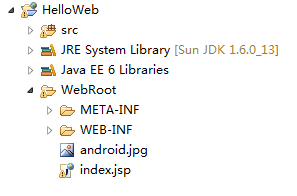Java和Android Http连接程序:使用java.net.URL 下载服务器图片到客户端
Java和Android Http连接程序:使用java.net.URL 下载服务器图片到客户端
本博客前面博文中利用org.apache.http包中API进行Android客户端HTTP连接的例子:
Android HTTP实例 使用GET方法和POST方法发送请求
另一种常用的建立Http连接的常用方式是利用Java在JDK中提供的类,也即本文要演示的方法,本文的例子程序实现的功能是从服务器上下载图片到客户端。
关于两种建立Http连接方法(apache的包和JDK的包)的讨论可以看看后面的参考链接。
服务器端
服务器端需要准备图片,因为是Demo程序,所以我就准备了一张图片,然后把它放在Web Project的WebRoot路径下:

然后只要启动Tomcat,ipconfig查出ip地址,放在之后要用的路径中就可以了。
Java程序:Http连接 获取并下载服务器端图片
写一个工具类:
其中第一个方法根据给出的服务器地址及资源路径得到输入流:
public static InputStream getInputStream(String path) { InputStream inputStream = null; HttpURLConnection httpURLConnection = null; try { URL url = new URL(path); if (null != url) { httpURLConnection = (HttpURLConnection) url.openConnection(); // 设置连接网络的超时时间 httpURLConnection.setConnectTimeout(5000); // 打开输入流 httpURLConnection.setDoInput(true); // 设置本次Http请求使用的方法 httpURLConnection.setRequestMethod("GET"); if (200 == httpURLConnection.getResponseCode()) { // 从服务器获得一个输入流 inputStream = httpURLConnection.getInputStream(); } } } catch (MalformedURLException e) { e.printStackTrace(); } catch (IOException e) { e.printStackTrace(); } return inputStream; }
第二个方法根据输入流将文件存储在本地一个路径:
public static void saveInputStream(InputStream inputStream, String saveToPath) { byte[] data = new byte[1024]; int len = 0; FileOutputStream fileOutputStream = null; try { fileOutputStream = new FileOutputStream(saveToPath); while (-1 != (len = inputStream.read(data))) { fileOutputStream.write(data, 0, len); } } catch (IOException e) { e.printStackTrace(); } finally { if (null != inputStream) { try { inputStream.close(); } catch (IOException e) { e.printStackTrace(); } } if (null != fileOutputStream) { try { fileOutputStream.close(); } catch (IOException e) { e.printStackTrace(); } } } }
完整代码:

package com.meng.utils; import java.io.FileOutputStream; import java.io.IOException; import java.io.InputStream; import java.net.HttpURLConnection; import java.net.MalformedURLException; import java.net.URL; public class HttpUtils { public static InputStream getInputStream(String path) { InputStream inputStream = null; HttpURLConnection httpURLConnection = null; try { URL url = new URL(path); if (null != url) { httpURLConnection = (HttpURLConnection) url.openConnection(); // 设置连接网络的超时时间 httpURLConnection.setConnectTimeout(5000); // 打开输入流 httpURLConnection.setDoInput(true); // 设置本次Http请求使用的方法 httpURLConnection.setRequestMethod("GET"); if (200 == httpURLConnection.getResponseCode()) { // 从服务器获得一个输入流 inputStream = httpURLConnection.getInputStream(); } } } catch (MalformedURLException e) { e.printStackTrace(); } catch (IOException e) { e.printStackTrace(); } return inputStream; } public static void saveInputStream(InputStream inputStream, String saveToPath) { byte[] data = new byte[1024]; int len = 0; FileOutputStream fileOutputStream = null; try { fileOutputStream = new FileOutputStream(saveToPath); while (-1 != (len = inputStream.read(data))) { fileOutputStream.write(data, 0, len); } } catch (IOException e) { e.printStackTrace(); } finally { if (null != inputStream) { try { inputStream.close(); } catch (IOException e) { e.printStackTrace(); } } if (null != fileOutputStream) { try { fileOutputStream.close(); } catch (IOException e) { e.printStackTrace(); } } } } }
测试程序:
package com.meng.learn; import java.io.InputStream; import com.meng.utils.HttpUtils; public class HttpTest { private static String URL_PATH = "http://192.168.11.6:8080/HelloWeb/android.jpg"; public static void main(String[] args) { InputStream inputStream = HttpUtils.getInputStream(URL_PATH); HttpUtils.saveInputStream(inputStream,"D:\\test1.jpg"); } }
程序运行成功之后可以在指定路径下发现多了服务器端的那个图片。
Android客户端 Http连接:下载服务器端的图片到SD卡
Android的程序还需要考虑的几点是:
1.对SD卡的访问权限及操作。
2.为了不阻塞UI线程,下载操作放在独立的线程中。
3.加入了网路访问的检查,确认网络连接后再进行下载。
需要添加的权限
<!-- 往SDCard写入数据权限 --> <uses-permission android:name="android.permission.WRITE_EXTERNAL_STORAGE" /> <!-- 联网权限 --> <uses-permission android:name="android.permission.INTERNET" /> <!-- 获取网络状态的权限 --> <uses-permission android:name="android.permission.ACCESS_NETWORK_STATE" />
布局文件如下:

<LinearLayout xmlns:android="http://schemas.android.com/apk/res/android" xmlns:tools="http://schemas.android.com/tools" android:layout_width="match_parent" android:layout_height="match_parent" android:orientation="vertical" > <TextView android:padding="10dp" android:id="@+id/info" android:layout_width="match_parent" android:layout_height="wrap_content" android:textSize="14sp" /> <Button android:id="@+id/btn" android:layout_width="match_parent" android:layout_height="wrap_content" android:text="Download Image" android:textSize="14sp" /> <ImageView android:padding="10dp" android:id="@+id/image" android:layout_width="match_parent" android:layout_height="match_parent" /> </LinearLayout>
Activity中所做的就是按下按钮之后,连接服务器,将图片取出显示在ImageView里,同时存往SD卡的指定路径:
package com.mengexample.test; import java.io.InputStream; import com.windexample.utils.FileUtils; import com.windexample.utils.HttpUtils; import android.app.Activity; import android.content.Context; import android.graphics.Bitmap; import android.graphics.BitmapFactory; import android.net.ConnectivityManager; import android.net.NetworkInfo; import android.os.AsyncTask; import android.os.Bundle; import android.view.View; import android.view.View.OnClickListener; import android.widget.Button; import android.widget.ImageView; import android.widget.TextView; import android.widget.Toast; public class ImageDownloadActivity extends Activity { private static String URL_PATH = "http://192.168.11.6:8080/HelloWeb/android.jpg"; private TextView mTextView = null; private Button mButton = null; private ImageView mImageView = null; @Override protected void onCreate(Bundle savedInstanceState) { super.onCreate(savedInstanceState); setContentView(R.layout.activity_image_download); mTextView = (TextView) findViewById(R.id.info); mTextView.setText(URL_PATH); mButton = (Button) findViewById(R.id.btn); mButton.setOnClickListener(mBtnClickListener); mImageView = (ImageView) findViewById(R.id.image); } private OnClickListener mBtnClickListener = new OnClickListener() { @Override public void onClick(View v) { // 首先确认网络连接 ConnectivityManager connectivityManager = (ConnectivityManager) getSystemService(Context.CONNECTIVITY_SERVICE); NetworkInfo networkInfo = connectivityManager .getActiveNetworkInfo(); if (null != networkInfo && networkInfo.isConnected()) { new DownloadImageTask().execute(URL_PATH); } else { Toast.makeText(ImageDownloadActivity.this, "No network connection available", Toast.LENGTH_SHORT) .show(); } } }; private class DownloadImageTask extends AsyncTask<String, Void, Bitmap> { @Override protected Bitmap doInBackground(String... params) { String path = params[0]; InputStream inputStream = HttpUtils.getInputStream(path); // 从输入流得到位图 Bitmap bitmap = BitmapFactory.decodeStream(inputStream); // 将图像存储到SD卡 FileUtils.saveToSDCard(bitmap, "TestImage", "android.jpg"); return bitmap; } @Override protected void onPostExecute(Bitmap result) { // 将图像显示出来 mImageView.setImageBitmap(result); } } }
其中用到的两个工具类:
建立连接并获取输入流的方法和Java代码中的一样:
package com.windexample.utils; import java.io.IOException; import java.io.InputStream; import java.net.HttpURLConnection; import java.net.MalformedURLException; import java.net.URL; public class HttpUtils { public static InputStream getInputStream(String path) { InputStream inputStream = null; HttpURLConnection httpURLConnection = null; try { URL url = new URL(path); if (null != url) { httpURLConnection = (HttpURLConnection) url.openConnection(); // 设置连接网络的超时时间 httpURLConnection.setConnectTimeout(5000); // 打开输入流 httpURLConnection.setDoInput(true); // 设置本次Http请求使用的方法 httpURLConnection.setRequestMethod("GET"); if (200 == httpURLConnection.getResponseCode()) { // 从服务器获得一个输入流 inputStream = httpURLConnection.getInputStream(); } } } catch (MalformedURLException e) { e.printStackTrace(); } catch (IOException e) { e.printStackTrace(); } return inputStream; } }
另一个辅助类提供了方法,将位图存入SD卡的指定路径:
package com.windexample.utils; import java.io.File; import java.io.FileNotFoundException; import java.io.FileOutputStream; import java.io.IOException; import android.graphics.Bitmap; import android.os.Environment; import android.util.Log; public class FileUtils { private static String TAG = "File"; public static String getSDCardRootPath() { // SD卡根目录 String sDCardRoot = Environment.getExternalStorageDirectory() .getAbsolutePath(); return sDCardRoot; } public static void saveToSDCard(Bitmap bitmap, String filePath, String fileName) { // 将所给文件路径和文件名与SD卡路径连接起来 String sdcardRoot = getSDCardRootPath(); // 创建文件路径 File dir = new File(sdcardRoot + File.separator + filePath); Log.i(TAG, "dir: " + dir); if (!dir.exists()) { dir.mkdirs(); } File targetFile = new File(dir, fileName); try { targetFile.createNewFile(); FileOutputStream fileOutputStream = new FileOutputStream(targetFile); bitmap.compress(Bitmap.CompressFormat.JPEG, 100, fileOutputStream); fileOutputStream.flush(); fileOutputStream.close(); } catch (FileNotFoundException e) { e.printStackTrace(); } catch (IOException e) { e.printStackTrace(); } } }
程序运行后并得到图片后,结果如下:

并且查看SD卡下的TestImage路径,发现其中有这个图片文件。
参考资料
Android Training: Connecting to the Network:
http://developer.android.com/training/basics/network-ops/connecting.html
Android Training: Processes and Threads
http://developer.android.com/guide/components/processes-and-threads.html
老罗Android开发视频教程。
Android之网络编程 系列博文:
http://www.cnblogs.com/devinzhang/category/349642.html
本博客前面博文中利用org.apache.http包中API进行Android客户端HTTP连接的例子:
Android HTTP实例 使用GET方法和POST方法发送请求
